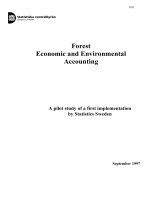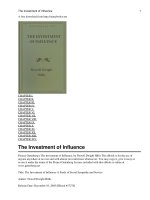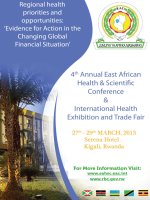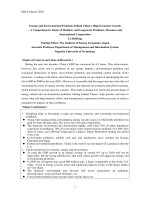Study of pharmacokinetics of prenylflavonoids and dynamics of estrogen action in sera following ingestion of epimedium using validated, ultra sensitive cell based bioassays 2
Bạn đang xem bản rút gọn của tài liệu. Xem và tải ngay bản đầy đủ của tài liệu tại đây (2.01 MB, 103 trang )
82
CHAPTER 3
RESULTS
3.1
Measurement of combinatorial estrogenic activity using ultra-
sensitive, cell-based ER-driven reporter gene assays
85
3.1.1
Responses of ERα- and β-driven reporter gene assays to
estradiol and its metabolites
85
3.1.2
Specificity of ER-driven reporter gene assays
88
3.1.3
Validation of ERα and ERβ cell-based bioassays
90
3.1.4
Isoform selectivity of DPN, PPT and genistein
93
3.1.5
Estrogenicity of common flavonoids and Epimedium
prenylflavonoids
95
3.1.6
Anti-estrogenic activities of SERMs and ER-antagonist in
ERα and ERβ cell lines
99
3.1.7
Combinatorial effects of binary mixtures of estradiol with
genistein and Epimedium prenylflavonoids
101
3.2
Combinatorial cell proliferative effects on estrogen-responsive
MCF-7 breast cancer cells
104
3.2.1
MCF-7 breast cancer cell proliferative effects of estradiol and
its metabolites
104
3.2.2
Effects on estradiol-induced breast cancer cell growth by
endogenous steroids
107
3.2.3
Validation of MCF-7 breast cancer cell proliferation assay
109
3.2.4
Induction of MCF-7 breast cancer cell growth by Epimedium
prenylflavonoids and genistein
111
3.2.5
Effects on cell proliferation of estrogen-induced of MCF-7
breast cancer cells by Epimedium prenylflavonoids, genistein
and 4-hydroxytamoxifen
113
83
3.3
Traditionally prepared aqueous Epimedium decoction does not
exert significant estrogencity in humans revealed using a panel of
sensitive, cell-based estrogen-responsive bioassays
116
3.3.1
ERα bioactivity and concentration of estrogenic aglycones in
a traditionally prepared Epimedium decoction
116
3.3.2
Estrogenicity of serum before and following ingestion of
estradiol valerate and Epimedium pubescens decoction
118
3.3.3
Correlations of estrogen-responsive bioassays with estrone
and estradiol levels in human sera
123
3.4
Lack of estrogenicity of a traditionally prepared Epimedium
decoction was due to low bioavailability of estrogenic Epimedium
aglycones in humans
126
3.4.1
GC-MS method development
126
3.4.1.1
Sample extraction and derivatization
126
3.4.1.2
GC-MS characterization of derivatized genistein,
icaritin and desmethylicarition
128
3.4.1.3
Validation of GC-MS method
132
3.4.2
Concentrations of icaritin and desmethylicarition in human
sera obtained after oral ingestion of a traditionally prepared
Epimedium decoction
134
84
3.5
Vast majority of Epimedium prenylflavonoids were conjugated
and rendered non-estrogenic following oral ingestion of a
prenylflavonoid-enriched, standardized Epimedium extract in
rats
137
3.5.1
LC–MS/MS method development
137
3.5.1.1
Ion pair selection
137
3.5.1.2
Linearity
144
3.5.1.3
Matrix effects and stability
147
3.5.2
Unconjugated flavonoid content in rat sera following
administration of Epimedium
150
3.5.3
Total flavonoid content in rat sera after digestion with
glucuronidase/sulfatase
154
3.5.4
Measurement of estrogenic effects in rat sera using the ERα
bioassay
157
3.5.5
Estrogenic activity in sera after digestion with
glucuronidase/sulfatase
159
3.6
Convergence of global gene expression profiles of MCF-7 breast
cancer cells treated with estradiol, genistein, Epimedium extract
and its compounds
160
3.6.1
Global gene expression profiles of estradiol, genistein, 4-
hydroxytamoxifen, Epimedium extract and its compounds in
human MCF-7 breast cancer cells
160
3.6.2
Comparison of gene expression profiles of genistein,
Epimedium extract, icariside I, icaritin, desmethylicaritin to
estradiol
166
3.6.3
Gene functions specific to genistein, Epimedium extract,
icariside I, icaritin and desmethylicaritin
168
3.6.4
Effects of estradiol, genistein, 4-hydroxytamoxifen,
Epimedium extract and its compounds on GREB1 expression
in human MCF-7 breast cancer cells.
179
3.7
Summary of findings
181
85
3.1 Measurement of combinatorial estrogenic activity using ultra-sensitive,
cell-based ER-driven reporter gene assays
3.1.1 Responses of ERα- and β-driven reporter gene assays to estradiol and its
metabolites
To examine their response to natural steroidal estrogens, ERα and ERβ stable
cells that the bioassays were based on were exposed separately to increasing doses of
estradiol and its metabolites, namely, estrone and estriol, which were dissolved in
Eagle’s minimum essential medium supplemented with 10% charcoal-stripped fetal
calf serum for 24 h. All three estrogenic ligands exhibited a sigmoidal dose-response
behavior in both cell lines (Fig. 10). Estrone and estriol were full agonists towards
both ER isoforms as they elicited the same maximum activation level of the luciferase
reporter gene as estradiol.
Dose-response experiments with the standard estrogen, estradiol, indicated that
the ERα stable cell line had an EC
50
value of 85 pM for this compound (Table 4).
Estradiol was a less potent activator of the ERβ cell line and its EC
50
value was about
3-fold higher than that observed with ERα (232 and 85 pM for ERβ and ERα
respectively) (Table 4).
Estriol and estrone were less potent agonists for both ERα and ERβ compared
to estradiol (Table 4). The rank order in terms of descending estrogenic potencies for
these three natural steroidal estrogenic ligands in both cell lines is estradiol > estriol >
estrone.
86
Figure 10: Dose-dependent activation of the luciferase reporter gene in ERα and
ERβ cells by estradiol and its metabolites.
ERα (A) or ERβ (B) cells were exposed to increasing doses of estrone (─■─),
estradiol (─○─) and estriol (─×─) dissolved in Eagle’s minimum essential medium
supplemented with 10% charcoal-stripped fetal bovine serum for 24 h. Results are
expressed as a percentage relative to saturation dose of estradiol and presented as
mean ± SEM.
0
20
40
60
80
100
120
Estrogenic Activity
(% of 10 nM E2)
-14 -13 -12 -11 -10 -9 -8 -7 -6 -5 -4
0
20
40
60
80
100
120
log[ligand]
Estrogenic Activity
(% of 10 nM E2)
(A) ERα
(B) ERβ
87
Table 4: Estrogenic effects of natural estrogens, ER-isoform selective agents,
common flavonoids and Epimedium prenylflavonoids measured in-vitro w i th E R -
driven luciferase reporter genes in HeLa cells stably expressing ERα or ERβ.
EC
50
(nM)
E
max
(% of 10 nM estradiol)
Compound
ERα
ERβ
ERα
ERβ
Natural estrogens
Estradiol
0.09±0.01
0.23±0.04
100
100
Estrone
6.9±1.1
86±1.1
100
100
Estriol
0.7±1.1
6.4±1.1
100
100
Isoform-selective agents
PPT
0.16±1.16
NSA
100
NSA
DPN
101±1.2
2.2±1.2
100
100
Genistein
921±1.4
137±1.2
461
544
Common flavonoids
Apigenin
2463±1.1
868±1.1
323
187
Kaempferol
3898±1.1
429±1.2
175
73.9
Luteolin
4769±1.1
2464±1.0
181
98.7
Quercetin
8124±1.1
2946±1.1
53.6
9.90
Epimedium prenylflavonoids
Icariin
NSA
NSA
NSA
NSA
Icariside I
5457±1.8
NSA
43.9
NSA
Icariside II
13070±1.8
6770±1.0
43.3
22.8
Icaritin
839±1.2
NSA
68.8
NSA
Desmethylicaritin
71±1.6
79±7.2
44.7
14.3
EC
50
: Half-maximal activity extrapolated from dose-response curves; numbers are
given in presented as the mean ± SEM from three determinations.
E
m a x
: Maximum estrogenic effect extrapolated from dose-response curves
NSA: No significant activity
88
3.1.2 Specificity of ER-driven reporter gene assays
In addition to estrogens, there are other endogeneous steroids present in the
blood in-vivo, for example, testosterone, cortisol, dihydrotestosterone and
progesterone. Hence, it is necessary to test for cross reactivity between these
endogeneous steroids with estrogens. To do this, ERα and ERβ stable cells were
incubated with increasing doses of steroidal hormones in the presence of 50 pM
estradiol and their effects on estradiol’s estrogenicity.
Addition of dihydrotestosterone did not change the estrogenicity of estradiol as
measured by ERα and ERβ bioassays (Fig. 11). Similar addition of cortisol or
progesterone also did not change the estrogenicity of the added estradiol. However,
dose-dependent increases in serum estrogenicity were detected when cells were
treated with increasing doses of testosterone in the presence of estradiol (Fig. 11).
This increase was due to the conversion of testosterone to estradiol by aromatase in
the cells, which was prevented by the addition of 50 µM of DL-aminoglutethimide, an
aromatase inhibitor, to all samples during the assay. D L -aminoglutethimide also
inhibits the transformation of androstenedione to estrone (Mak et al., 1999).
89
Figure 11: Effects of endogenous steroids on the estrogenicity of 50 pM of
estradiol in ER-driven reporter gene assays.
ERα (A, B) and ERβ (C, D) stable cells were incubated with increasing doses of
progesterone (―■―), dihydrotestosterone (―□―), hydroxycortisone (―•―) and
testosterone (―○―) in the presence of 50 pM estradiol. Dose-response curves were
obtained in the absence (A, C) and presence of 50 µM of DL-aminoglutethimide, AG
(B, D). Results are expressed as fold induction relative to vehicle treated control and
presented as the mean ± SEM, (* p<0.01).
0
2
4
6
8
Fold Induction over vehicle
0
1
2
3
4
0 50 50 50 50 pM E2
0 0 10 100 1000 pM steroid
Fold Induction over Vehicle
0 50 50 50 50 pM E2
0 0 10 100 1000 pM steroid
(A) ERα
(B) ERα
(D) ERβ
(C) ERβ
─ 50 µM AG
─ 50 µM AG
+ 50 µM AG
+ 50 µM AG
Fold Induction over vehicle
Fold Induction over vehicle
*
*
*
*
90
3.1.3 Validation of ERα and ERβ cell-based bioassays
The inter- and intra-assay variations of both ERα and ERβ bioassays, were
determined by using 0.1 nM and 0.5 nM of estradiol, respectively. Inter-assay
variation is defined as the relative SD from the mean of determinations done on 10
different occasions. Intra-assay variation is the relative SD of the mean of 8
determinations in a single assay. The sensitivity towards the standard estrogen,
estradiol, for both assays was ascertained by determining the detection limit, which is
the concentration of estradiol that induced a luciferase activity equivalent to the mean
plus three SD of vehicle (Legler et al., 1999).
For ERα, dose-response experiments with estradiol indicated that the detection
limit was 8.45 pM. Intra- and inter-assay variations near the EC
50
value (0.1 nM) were
about 6% and 14%, respectively. As for ERβ, the detection limit, intra- and inter-
assay variations were 13.1 pM, 8.1% and 16% respectively, which are relatively
similar to that for ERα.
To quantify the estrogenicity of serum samples obtained from volunteers who
have ingested an estrogenic preparation during a clinical trial, calibration curves need
to be constructed alongside these samples. Estrogenicity of these serum samples can
be expressed as estradiol equivalents, which can be derived by interpolation from the
calibration curve. Calibration curves using estradiol were constructed by adding
increasing doses of estradiol to charcoal-treated serum. The aromatase inhibitor, DL-
aminoglutethimide, needs to be added to all samples at a final concentration 50 µM,
so as to minimize the conversion of endogenous testosterone to estradiol. Resulting
calibration curves, with luminescence readings on the y-axis and estradiol
concentrations on the x-axis, were then fitted with the regression method that visually
91
best fits the points within the range of the test samples that maximizes the correlation
coefficient using Graphpad Prism software.
A representative ERα calibration curve generated by exposing ERα cells to
increasing doses of estradiol is shown in Fig. 12A. The curve was best fitted with a
power regression curve within the clinical range (R
2
> 0.95). A representative ERβ
calibration curve within the clinical range was best fitted with a exponential curve
with a correlation coefficient of R
2
> 0.95 (Fig. 12B).
92
Figure 12: Representative calibration curves of ER-driven reporter gene
bioassays for the quantification of estrogenicity of ex-vivo serum samples.
Calibration curves were constructed by adding increasing doses of estradiol to
dextran-coated, charcoal-treated serum and then equilibrated for 4 h at 37ºC. All
serum samples were diluted to 20% with serum-free media before exposure to ERα
and ERβ cells in duplicate. The aromatase inhibitor DL-aminoglutethimide at a final
concentration of 50 µM was added to every sample. Calibration curves were fitted
with a suitable regression method which maximizes the correlation coefficient within
the range of the test samples. Luminescence is given as relative light units (RLU).
0
2 5
5 0
7 5
1 0 0
1 2 5
1 5 0
1 7 5
2 0 0
0
2 5
5 0
7 5
1 0 0
y = 0 .4 9 x - 1 . 4
r
2
= 0 .9 9
[E2], pM
L um i n e s cence
(B)
(A)
ERβ
ERα
0 25 50 75 100 125 150 175 200
0
250
500
750
1000
[E2], pM
Luminescence
y = 320 - [39185/(1- exp(314-x)/37]
r
2
= 0.98
93
3.1.4 Isoform selectivity of DPN, PPT and genistein
To assess the ER-isoform selectivity of ERα and ERβ bioassays, compounds
such as, DPN, PPT and genistein, which are non-steroidal compounds that have been
reported to show ER isoform selectivity were tested.
PPT was reported to be an ERα-selective ligand (Escande et al., 2006). As
shown in Fig. 13A, PPT exhibited strong ERα selectivity, with EC
50
value of 0.163
nM (Table 4). It showed negligible transactivation of the luciferase reporter gene in
the ERβ cell line in the range of concentrations tested. PPT showed a full ERα
agonistic activity as its maximal activation of the luciferase reporter gene was similar
to that obtained for estradiol.
DPN transactivated both cell lines with EC
50
values of 101 nM and 2.16 nM
for ERα and ERβ, respectively (Fig. 13B). It is a ERβ-selective ligand that showed
~50 fold higher relative potency for the ERβ isoform. DPN is a full ERα agonist for
both ERα and ERβ cell lines.
Genistein is a phytoestrogen present in soy that has been reported to be a weak
ERβ selective phytoestrogen (Escande et al., 2006). As shown in Fig. 13C, genistein
showed ~7 fold higher potency for the ERβ isoform (EC
50
values for ERα was 921
nM and ER β was 137 nM, Table 4). In contrast with PPT and DPN, genistein is a
superagonist in both ERα and ERβ cell lines, where the maximal activation of the
luciferase reporter gene was ~5-fold higher than that obtained for estradiol.
94
Figure 13: Isoform selectivity of PPT, DPN and genistein.
ERα (―•―) and ERβ (―○―) stable cells were exposed to increasing doses of (A)
PPT; (B) DPN and (C) genistein (GEN), for 24 h. Results are expressed as a
percentage relative to saturation dose of estradiol and presented as the mean ± SEM.
-13
-12
-11
-10
-9
-8
-7
-6
-5
-4
-3
0
100
200
300
400
500
Genistein
log[ligand], M
Estrogenic Activity
(% of 10 nM E2)
(C)
0
20
40
60
80
100
120
ERα
ERβ
PPT
Estrogenic Activity
(% of 10 nM E2)
0
20
40
60
80
100
120
DPN
Estrogenic Activity
(% of 10 nM E2)
(B)
(A)
PPT
DPN
GEN
95
3.1.5 Estrogenicity of common flavonoids and Epimedium prenylflavonoids
Estrogenic effects of four common flavonoids were examined and compared to
estradiol using ERα and ERβ bioassays. Flavonoids studied were the flavones
(apigenin, luteolin) and flavonols (kaempferol, quercetin) commonly present in the
diet. These compounds were paradigms for phytoestrogens with 3 hydroxyl (apigenin),
4 hydroxyl (luteolin and kaempferol) and 5 hydroxyl (quercetin) groups, allowing the
study of relative estrogenic activity contributed by these hydroxyl groups (Table 1).
The ERα effects exerted by the four flavonoids are ~ 5 to 6 orders of
magnitude less potent than estradiol (Fig. 14A). Relative bioactivities, in terms of
EC
50
values and peak activities were - apigenin>kaempferol=luteolin>quercetin -
corresponding to increasing number of hydroxyl groups. Apigenin, kaempferol and
luteolin induced superagonist effects, with relative peak activities that were 1.7- to
3.2-fold higher than that observed with maximal doses of estradiol. Peak activity of
quercetin was only half of that observed for estradiol.
Apigenin, luteolin, kaempferol and quercetin were relatively more potent
stimulators of ERβ than ERα, with EC
50
value that was 2 to 3 times smaller than ERα
(Table 4, Fig. 14B). Apigenin with 3 hydroxyl groups and quercetin with 5 hydroxyl
groups exhibited most and least relative ERβ potencies respectively. Kaempferol and
luteolin had potencies and peak activities that were intermediate between apigenin and
quercetin. Kaempferol was more potent than luteolin. Superagonism was observed for
apigenin, but not kaempferol and luteolin. Quercetin was a weak stimulator of ERβ.
The estrogenic effects of prenylflavonoids found in Epimedium were also
examined. Dose-response curves were constructed by exposing ERα and ERβ to
increasing doses of individual prenylflavonoids. Icariin was non-estrogenic as it did
96
not exhibit either ERα or ERβ activity. Desmethylicaritin, icaritin, icariside I, and
icariside II are partial ERα agonists which induced ERα activity that was about 45%
of the peak activity observed for estradiol (Fig. 15A). The potency of the compounds
were in the order desmethylicaritin > icaritin > icariside I > icariside II with their EC
50
values being 0.07, 0.84, 5.5 and 13 µM respectively (Table 4). Icaritin and icariside I
were ERα-selective as these compounds did not stimulate ERβ activity (Fig. 15B).
Icariside II and desmethylicaritin exhibited slight ERβ activity corresponding to 20%
of that observed with estradiol.
97
Figure 14: Estrogenic activity of common flavonoids in-vitro.
(A) ERα or (B) ERβ cells were exposed to increasing doses of apigenin (―×―),
kaempferol (―■―), luteolin (―∆―) and quercetin (―○―). Apigenin showed
superagonist effects in both ERα and ERβ stable cells that are above the maximal
activation observed for the ER cognate ligand, estradiol. Kaempferol and luteolin are
superagonists in ERα but not ERβ cells. Quercetin is a partial agonist in both systems.
Results are expressed as a percentage relative to saturation dose of estradiol and
presented as mean ± SEM.
-8
-7
-6
-5
-4
0
50
100
150
200
log[ligand], M
Estrogenic Activity
(% of 10 nM E2)
(B)
ERβ
-7
-6
-5
-4
-3
0
100
200
300
400
A
K
L
Q
Estrogenic Activity
(% of 10 nM E2)
(A)
ERα
98
Figure 15: Estrogenic activity of Epimedium prenylflavonoids in-vitro.
HeLa cells stably expressing ERα (A) and ERβ (B) proteins and an ER-driven
luciferase reporter gene, pERE4-Luc
hygro
were exposed to increasing concentrations of
estradiol (□), icariin (×), icariside II (○), icariside I (●), icaritin
(▲) and desmethylicaritin (Δ). Epimedium prenylflavonoids preferentially
activate the ERα isoform and icariside I and icaritin are both ERα-selective agents.
Those that activated the ER showed partial agonistic activity. Estrogenic activity of
ligands is expressed as a percentage of maximal effect observed with 10 nM estradiol.
0
20
40
60
80
100
120
DICT
ICT
ICA
ICAR I
ICAR II
E2
ERα
Estrogenic Activity
(% of 10 nM E2)
- 1 4
- 1 3
- 1 2
- 1 1
- 1 0
- 9
- 8
- 7
- 6
- 5
- 4
0
2 0
4 0
6 0
8 0
1 0 0
1 2 0
ERβ
[ l i g a n d ] , M
Es tr ogen ic Activity
(% of 10 nM E2)
(A)
(B)
ERα
ERβ
99
3.1.6 Anti-estrogenic activities of SERMs and ER-antagonist in ERα and ERβ
cell lines
The ability of ERα and ERβ bioassays to detect anti-estrogenic activity was
studied by exposing cells to 4-hydroxytamoxifen, raloxifene and ICI182,780 in the
presence of EC
50
concentration of estradiol (Fig. 16).
Both 4-hydroxytamoxifen and ICI 182,780 showed relatively similar
antagonistic activities towards the two stable cell lines (Fig. 16A, B). They were also
more antagonistic towards the ERβ isoform where ICI 182,780 and 4-
hydroxytamoxifen showed ~3 and ~2 fold more potent estrogen antagonistic activity
towards ERβ over ERα isoform.
On the other hand, raloxifene was a more potent ERα antagonist with ~500
times more selectivity for ERα over ERβ. Interestingly, raloxifene was the weakest
ERβ but the most potent ERα antagonist among the three compounds tested.
100
Figure 16: Anti-estrogenic activities of SERMs and ER-antagonist in the
presence of EC
50
concentration of estradiol.
ERα (A) or ERβ (B) cells were exposed to increasing doses of ICI 182,780 (―○―),
4-hydroxytamoxifen (―•―) and raloxifene (―×―) in 10% serum in the presence of
0.1 nM (ERα) and 0.5 nM (ERβ) of estradiol, respectively. Results are expressed as a
percentage relative to saturation dose of estradiol and presented as the mean ± SEM.
Both 4-hydroxytamoxifen and ICI 182,780 showed relatively similar antagonistic
activities towards the two stable cell lines and were more antagonistic towards the
ERβ isoform. Raloxifene was a more potent ERα antagonist.
0
10
20
30
40
50
60
ERβ
ERα
ICI 182,780
Estrogenic Activity
(% of 10 nM E2)
(A)
-13 -12 -11 -10 -9 -8 -7 -6 -5 -4
0
10
20
30
40
50
60
Raloxifene
log[ligand]
Estrogenic Activity
(% of 10 nM E2)
(C)
0
10
20
30
40
50
60
4-hydroxytamoxifen
Estrogenic Activity
(% of 10 nM E2)
(B)
ICI 182,780
IC
50
(
ERα
):
7.2 nM
IC
50
(
ERβ
):
2.3 nM
4-hydroxytamoxifen
IC
50
(
ERα
):
7.9 nM
IC
50
(
ERβ
):
4.1 nM
Raloxifene
IC
50
(
ERα
):
0.02 nM
IC
50
(
ERβ
):
10.1 nM
101
3.1.7 Combinatorial effects of binary mixtures of estradiol with genistein and
Epimedium prenylflavonoids
To study combinatorial effects of flavonoids and estradiol, binary mixtures
containing increasing doses of genistein and Epimedium prenylflavonoids in the
presence of an EC
50
dose of estradiol were separately tested in ERα and ERβ
bioassays.
Genistein was the only compound tested that showed agonistic effects in the
presence of estradiol. Luciferase induction in treatments where genistein was
incubated with estradiol in ERα and ERβ cell lines was higher than the maximal level
elicited by 10 nM of estradiol (Fig. 17A & 18A).
Of the five Epimedium prenylflavonoids, icariin, which is a diglycoside, did
not show any agonistic or antagonistic activity towards estrogen-induced luciferase
activity in the concentration range tested (Fig. 17B & 18B).
The remaining four Epimedium prenylflavonoids, namely, monoglycosides,
icariside I and icariside II and aglycones, icaritin and desmethylicaritin, did not
exhibit significant agonistic activity in the presence of estradiol in both cell lines (Fig.
17C-D, Fig. 18C-D). These four compounds elicited reduced estrogen-induced
luciferase activity only at higher doses (> 10 µM), which was more apparent in the
ERβ than ERα cell line.
102
Figure 17: ERα combinatorial effects of binary mixtures of estradiol with
genistein and Epimedium prenylflavonoids.
ERα stable cells were incubated with increasing doses of genistein (A), icariin (B),
icariside I (C), icariside II (D), icaritin (E) and desmethylicaritin (F) in the presence of
0.1 nM of estradiol for 24 h. Genistein, in combination with estradiol, showed
superagonist effects. All Epimedium prenylflavonoids, except icariin, showed
antagonism towards estrogen-induced activity at doses > 10 µM. Results are
expressed as a percentage relative to saturation dose of estradiol and presented as the
mean ± SEM, (* p<0.01).
0
100
200
300
400
500
600
*
*
*
*
*
*
*
Estrogenic Activity
(% of 10 nM E2)
0
25
50
75
100
(A)
(B)
0
25
50
75
100
*
*
*
Estrogenic Activity
(% of 10 nM E2)
0
25
50
75
100
*
(C)
(D)
-6.5 -6.0 -5.5 -5.0 -4.5 -4.0
0
25
50
75
100
*
log[ligand], M
Estrogenic Activity
(% of 10 nM E2)
(E)
-6.5 -6.0 -5.5 -5.0 -4.5 -4.0
0
25
50
75
100
*
log[ligand], M
(F)
103
Figure 18: ERβ combinatorial effects of binary mixtures of estradiol with
genistein and Epimedium prenylflavonoids.
ERβ stable cells were incubated with increasing doses of genistein (A), icariin (B),
icariside I (C), icariside II (D), icaritin (E) and desmethylicaritin (F) in the presence of
0.5 nM of estradiol for 24 h. Genistein, in combination with estradiol, showed
superagonist effects. All Epimedium prenylflavonoids, except icariin, showed
antagonism towards estrogen-induced activity at doses > 10 µM. Results are
expressed as a percentage relative to saturation dose of estradiol and presented as the
mean ± SEM, (* p<0.01).
-6.5
-6.0
-5.5
-5.0
-4.5
-4.0
0
25
50
75
100
*
*
log[ligand], M
(F)
0
25
50
75
100
*
*
*
*
Estrogenic Activity
(% of 10 nM E2)
(C)
0
100
200
300
400
500
600
*
*
*
*
*
*
*
Estrogenic Activity
(% of 10 nM E2)
(A)
0
25
50
75
100
(B)
0
25
50
75
100
*
*
(D)
-6.5
-6.0
-5.5
-5.0
-4.5
-4.0
0
25
50
75
100
*
*
log[ligand], M
Estrogenic Activity
(% of 10 nM E2)
(E)
104
3.2 Combinatorial cell proliferative effects on estrogen-responsive MCF-7
breast cancer cells
3.2.1 MCF-7 breast cancer cell proliferative effects of estradiol and its
metabolites
A hallmark physiological response to estrogenic stimuli is the proliferation of
cells in-vivo. This can be studied in-vitro by using breast cancer cells such as MCF-7
cells which express mainly endogenous ERα and are known to respond to estrogens
and antiestrogens to modulate cell proliferation. The MCF-7 cell proliferation assay,
also known as the ‘E-screen’, is therefore used to study the physiological endpoint of
estrogen action and also discrimination of agonists from antagonists. Relative cell
numbers were determined by Invitrogen’s CyQuant system and relative cell
proliferation were expressed as fold-increase in fluorescence of test compound-treated
cells compared to that of vehicle treated cells, which is expressed as 1-fold.
The cell proliferative effects of estradiol were examined together with two of
its metabolites, namely, estrone and estriol. Estradiol was found to dose-dependently
induce ERα-positive MCF-7 cell proliferation, reaching a peak level at 100 pM, with
an EC
50
value of about 4 pM (Fig. 19), indicating the sensitivity of this assay towards
stimulation of estrogenic compounds. Estrone and estriol also induced cell
proliferation and their maximal cell proliferation levels were similar to what was
observed for estradiol, suggesting that they are full estrogen agonists. Based on their
EC
50
values presented in Table 5, the potency of these three endogeneous estrogens
were in the order estradiol > estriol > estrone.
105
Figure 19: MCF-7 breast cancer cell proliferative effects of estradiol and its
metabolites.
MCF-7 breast cancer cells were treated with increasing doses of estrone (―•―),
estradiol (―ο―) and estriol (―■―) dissolved in Eagle’s minimum essential medium
supplemented with 5% charcoal-stripped fetal calf serum for 6 days. Relative cell
proliferation is expressed as fold induction over the vehicle control and presented as
the mean ± SEM.
- 1 4 - 1 3 - 1 2 - 1 1 - 1 0 -9 -8 -7 -6 -5
0. 5
1. 0
1. 5
2. 0
2. 5
log[ligand]
Relative Cell Proliferation
( Fo l d ov er veh i cl e)
106
Table 5: Effects on the proliferation of MCF-7 breast cancer cells by natural
estrogens, common flavonoids and Epimedium prenylflavonoids measured in-
vitro.
EC
50
: Half-maximal activity extrapolated from dose-response curves.
E
m a x
: Maximum estrogenic effect extrapolated from dose-response curves.
NSA: No significant activity.
Compound
EC
50
(nM)
E
m a x
(fold induction over vehicle)
Natural estrogens
Estradiol
0.0042±0.0011
2.05
Estrone
0.99±0.13
2.08
Estriol
0.029±0.011
2.13
Phytoestrogens
Genistein
34±12
1.97
Icariin
NSA
NSA
Icariside I
797±128
1.74
Icariside II
4160±1100
1.56
Icaritin
604±118
1.90
Desmethylicaritin
135±7
1.92









